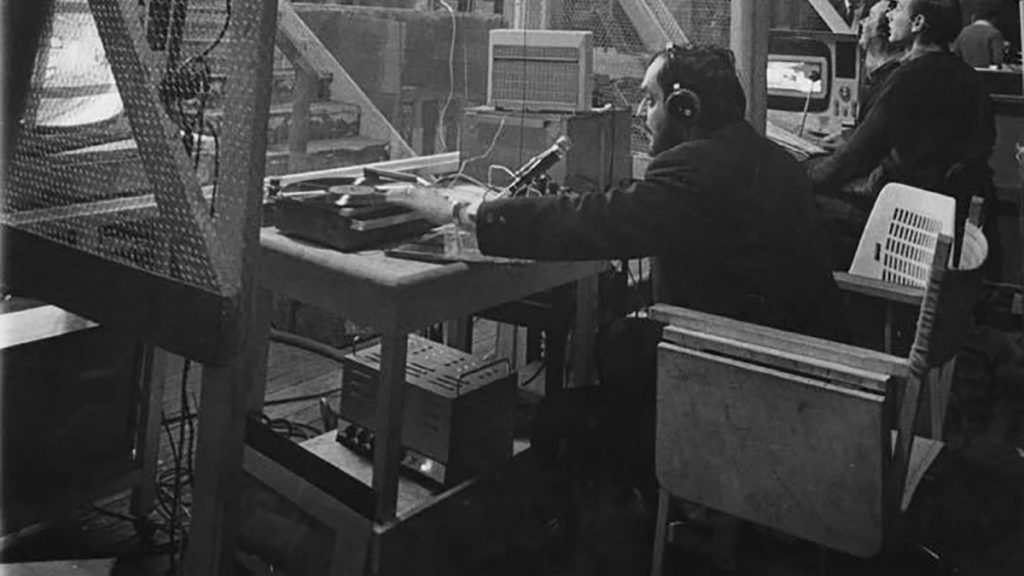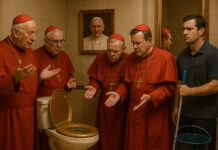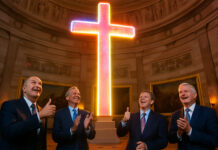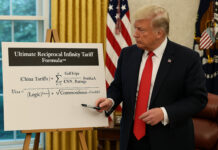Cape Kennedy, FL — A recently declassified document has revealed that NASA used real moon landing footage to fuel conspiracy theories that Apollo 11 and later missions didn’t happen. In her new book, What Really Happened on the Moon, French-born American author Rene S. Parker maintains that it was less expensive to go to the moon than produce a fake facsimile of it in a Hollywood studio.
Ms. Parker started her book journey in the Winter of 2001 when she received an anonymous FAX claiming to have intimate knowledge of what “really happened” during the Apollo missions. Over the next three months, she received over 400 pages of declassified NASA documents, dating back to 1960. The sender never identified himself but implied in several letters that he believed the world was ending and wanted to “get it off his chest.”
The anonymous sender also said he was dying of prostate cancer and didn’t have long to live.
Why Fake a Real Landing?
“I know all of this sounds counterintuitive, but you have to put yourselves back in the early 1960s,” said Ms. Parker referring to Chapter 4 of a book entitled ‘The Econ of Cold War Space.’ “It seems pretty clear back in 1960 that the United States had no idea what they were doing. Complicating matters, President Kennedy had just announced plans to go to the moon. So their first plan was just to fake the missions. But it wasn’t that simple.”
In her book, Ms. Parker claims that NASA couldn’t figure out how to fake the most costly part of the mission: the Saturn rockets.
“If you’re going to fake a mission to the moon,” continued Ms. Parker, “the first thing people are going to ask is, ‘how did you get there?’ So, they needed to build an expensive and massive rocket.”
It was simply cheaper to go to the moon and use fake footage filmed back on Earth.
“It makes complete sense once you get comfortable about the idea. I mean, they’re already shooting through space, so why not do it. We didn’t have the film or television technology to beam it live back to Earth. So that was done by Stanley Kubrick in Burbank, CA.”
Enter Film Director Stanley Kubrick

The United States Government contacted director Stanley Kubrick following the success of his 1964 black comedy Dr. Strangelove. According to Ms. Parker, her anonymous 2001 source coordinated Kubrick’s studio version of the moon landing with the real one.
“NASA chose him because he was simply the best director out there. And of course, there was his film 2001: A Space Odyssey, which came out a year before the Apollo 11 mission,” Ms. Parker opined. “NASA wasn’t too keen on him doing that, but he had them by the short hairs. He basically could do whatever he wanted. And he did. He even made them pay for parts of the production.”
Kubrick re-used much of his equipment and production staff to film 2001. And the most remarkable thing, according to Ms. Parker, is that no one outside of a close circle of people even noticed. But three Astronauts did land on the moon. The same ones billions saw that day were three actors on an elaborate sound stage outside Los Angeles, CA.
“No one noticed. No one noticed that Kubrick was doing both. They [The landing and 2001] both happened at the same time. My source was very proud of the fact that none of this leaked out to the public. But I think there’s a good reason for that.”
Why We Didn’t See It
1960s America obsessed over two things: the Soviet Union and the Beatles. The latter provided an easy distraction. However, the former required a more orchestrated effort from the government. And the Space Race provided the perfect cover.
“In retrospect, the space race was good for America even if it used propaganda. However, Kennedy and then later President Johnson knew we had to win it. When NASA first proposed faking the entire thing, Kennedy was OK with that. But after his assassination and the skyrocketing costs, Johnson insisted on making the real landing happen. However, he agreed that its media component needed to be perfect.”
Kubrick quickly realized that he had to “dumb down” the fake material and use crude and artificial “deteriorating” techniques, by today’s standards, to simulate television transmissions from what appeared to be almost 240,000 miles away.
“Kubrick thought of everything,” commented Ms. Parker rummaging through several worn facsimiles. “He deliberately added noise and video artifacts to the film. But not everything was that tricky. For the audio, she ran it through a telephone line to another studio.”
Does it Matter?
The fact of the matter is Americans didn’t want to see the faked portions of the Apollo missions. In retrospect, it doesn’t matter now because the United States won the Space Race. The production quality matched our expectations of what television from space would look like. However, it would be another 12 years until a real television transmission from space via the Space Shuttle.
NASA has refused to comment on Ms. Parker’s book but released a statement defending the agency’s integrity, saying it’s proud of its long history of leading the United States into the Space Age.






